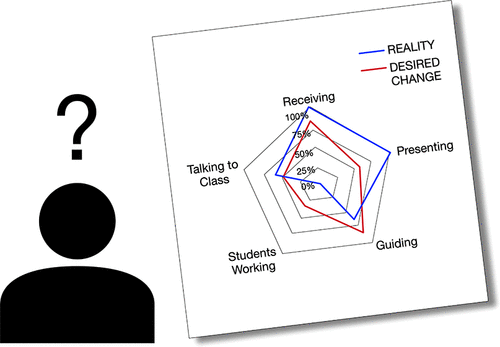当前位置:
X-MOL 学术
›
J. Chem. Educ.
›
论文详情
Our official English website, www.x-mol.net, welcomes your
feedback! (Note: you will need to create a separate account there.)
I’ve Been Given COPUS (Classroom Observation Protocol for Undergraduate STEM) Data on My Chemistry Class... Now What?
Journal of Chemical Education ( IF 2.5 ) Pub Date : 2020-03-11 , DOI: 10.1021/acs.jchemed.9b01066 Barbara A. Reisner 1 , Cole L. Pate 1 , Melissa M. Kinkaid 1 , Daniel M. Paunovic 1 , Justin M. Pratt 2 , Joanne L. Stewart 3 , Jeffrey R. Raker 2, 4 , Anne K. Bentley 5 , Shirley Lin 6 , Sheila R. Smith 7
Journal of Chemical Education ( IF 2.5 ) Pub Date : 2020-03-11 , DOI: 10.1021/acs.jchemed.9b01066 Barbara A. Reisner 1 , Cole L. Pate 1 , Melissa M. Kinkaid 1 , Daniel M. Paunovic 1 , Justin M. Pratt 2 , Joanne L. Stewart 3 , Jeffrey R. Raker 2, 4 , Anne K. Bentley 5 , Shirley Lin 6 , Sheila R. Smith 7
Affiliation

|
Classroom observation data using tools such as the Classroom Observation Protocol for Undergraduate STEM (COPUS) are frequently collected in instructional settings for large-scale research studies and program assessment. While COPUS data may be provided to instructors, it is often provided with little or no guidance on how the data can be used to inform teaching practice. This communication is designed to serve as a guide for chemistry instructors to understand the COPUS data from their course, facilitate engagement with the results, and provide strategies for making meaningful changes in response to the data.
中文翻译:

我在我的化学课上得到了COPUS(本科生STEM课堂观察协议)数据...现在怎么办?
使用诸如《大学生STEM课堂观察协议》(COPUS)之类的工具的课堂观察数据经常在教学环境中收集,以进行大规模的研究研究和计划评估。虽然可以将COPUS数据提供给教师,但通常很少或根本没有提供有关如何将这些数据用于教学实践的指导。这种交流旨在作为化学指导者从其课程中理解COPUS数据的指南,促进对结果的参与,并提供策略以对数据做出有意义的更改。
更新日期:2020-04-24
中文翻译:

我在我的化学课上得到了COPUS(本科生STEM课堂观察协议)数据...现在怎么办?
使用诸如《大学生STEM课堂观察协议》(COPUS)之类的工具的课堂观察数据经常在教学环境中收集,以进行大规模的研究研究和计划评估。虽然可以将COPUS数据提供给教师,但通常很少或根本没有提供有关如何将这些数据用于教学实践的指导。这种交流旨在作为化学指导者从其课程中理解COPUS数据的指南,促进对结果的参与,并提供策略以对数据做出有意义的更改。











































 京公网安备 11010802027423号
京公网安备 11010802027423号